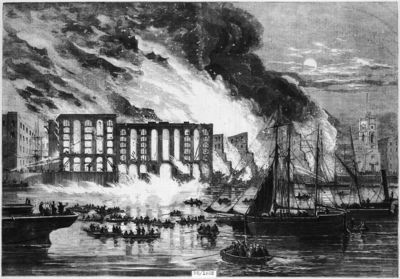
This part of Southwark has served as part of London's harbour since Roman times. Then after the opening of the original London Bridge in 1250 the area started to develop more. Monastic inns were built to serve country monks visiting London, such as the Inn of Battle Abbey on the site of Hay's Wharf.
After Henry VIII's dissolution of the monasteries, the area became more wharfage and commerce. The brick warehouses, that can still be seen today, were built in the I9th century. Fenning's, Cotton's and Hay's wharves were run by the proprietors of Hay's Wharf, who had been in the area for 300 years.
1807 Surrey Docks open.
1861. The Tooley Street fire was the greatest fire that London had seen since the Great Fire of London in 1666.

A riverside warehouse caught light when a fire started in consignment of jute stored at Scovell's warehouse at Cotton's Wharf. Before long every man in the force was fighting the blaze. The fire raged for two days, engulfing much of the Tooley Street areas before it was brought under control and it was not fully doused for a fortnight. The Tooley Street fire was too much for the insurance companies, who immediately raised their premiums. A committee was appointed and, after some debate, recommended that a Brigade be formed at public expense under the control of the Metropolitan Board of Works.The Metropolitan Fire Brigade Act was thus passed in 1865.
1864 St Saviours Dock fire
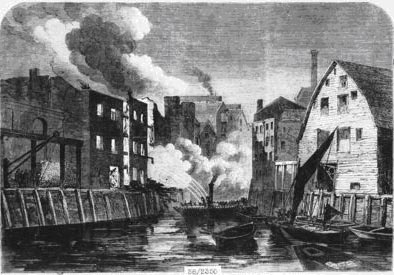 |
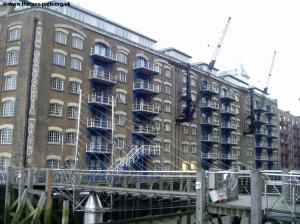 |
Fire St Saviour Dock 1864 |
St Saviours Dock in 2007 |
1889 Great Dock strike.

The London Dock Strike in 1889 was a major industrial dispute whch resulted in a victory for the strikers and established strong trade unions amongst London dockers. The dockers walked out en masse and paralysed the docks. The strike helped to draw attention to the problem of poverty in Victorian England and the dockers' cause attracted considerable public sympathyIt is said that the conditions in which the dockers lived and worked were pitiable and their demands modest.
The dock owners, however, would not compromise and the dispute became bitter and protracted. On the point of defeat by starvation, the strikers were saved by a spontaneous outpouring of generosity from their fellow workers in Australia.
The principal demand of the strike was for the 'dockers tanner' - a rate of 6d an hour. The strike was noted for large, peaceful processions which impressed middle-class opinion and won sympathy for the strikers' cause from figures such as Cardinal Manning. Cardinal Manning was the meditator between the striking workers and the dock owners. He was seen as fair and impartial by both sides. Upon the resolution of the strike, the dock workers collected 160 pounds for Manning in appreciation. Manning donated the money to a local hospital for a bed.
One newspaper reported:
" Dockmen, lightermen, bargemen, cement workers, carmen, ironworkers and even factory girls are coming out. If it goes on a few days longer, all London will be on holiday. The great machine by which five millions of people are fed and clothed will come to a dead stop, and what is to be the end of it all? The proverbial small spark has kindled a great fire which threatens to envelop the whole metropolis."
Colonel G.R. Birt, the general manager at Millwall Docks, gave evidence to a Parliamentary committee, on the physical condition of the workers:
"The poor fellows are miserably clad, scarcely with a boot on their foot, in a most miserable state ... These are men who come to work in our docks who come on without having a bit of food in their stomachs, perhaps since the previous day; they have worked for an hour and have earned 5d. [2p]; their hunger will not allow them to continue: they take the 5d. in order that they may get food, perhaps the first food they have had for twenty-four hours".
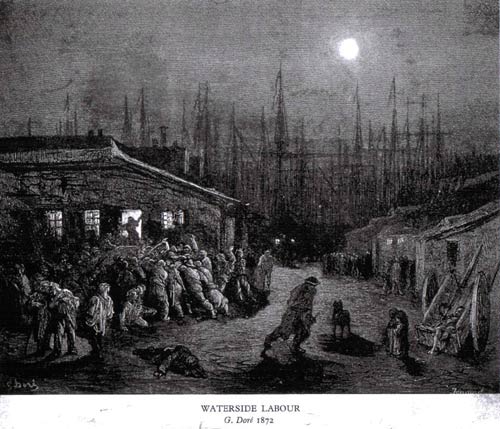
1939 to 1945 Second World War bombing destroyed the old frontage of Hay's Wharf.
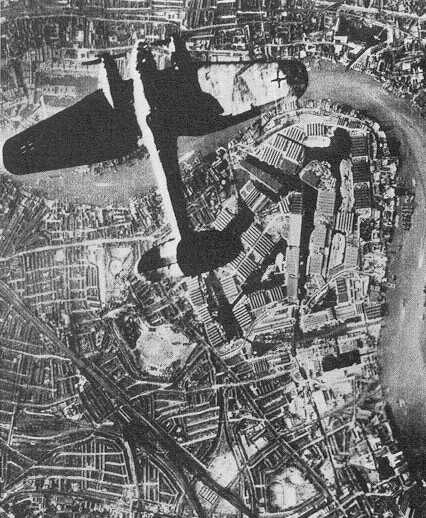
1960s the pattern of wharfage began to change with the introduction of containers, and by the 1970s river activity at the Surrey docks was virtually dead.
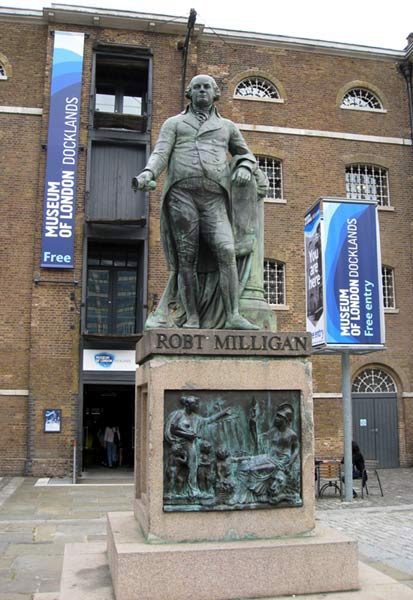
Docklands Museum, Canary Wharf. Covers the history of the London Docks.
References
The Great Dock Strike 1889 by Terry McCarthy. Foreword by Ron Todd. http://www.se16.btinternet.co.uk/getmapping.htm
has “poverty map” of area on it
http://www.umich.edu/~risotto/maxzooms/se/sek78.html this research applies to
1889
Return to Bermondsey History 1850 to 1939